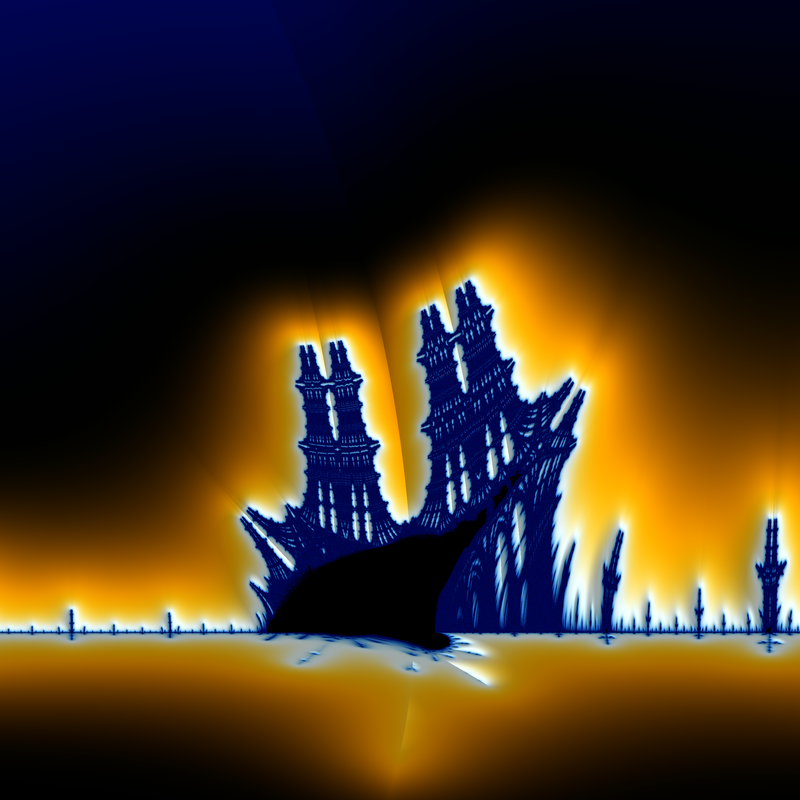Note
Click here to download the full example code
13 - Burning ship DEM
Plotting of a distance estimation for the Burning ship (power-2). This zoom is on the structure which gave the fractal its name. We use an arbitrary-precision model, even if this is obviously not needed here.
Reference:
fractalshades.models.Perturbation_burning_ship

import os
import numpy as np
import fractalshades as fs
import fractalshades.models as fsm
import fractalshades.colors as fscolors
from fractalshades.postproc import (
Postproc_batch,
Continuous_iter_pp,
DEM_normal_pp,
DEM_pp,
Raw_pp,
)
from fractalshades.colors.layers import (
Color_layer,
Bool_layer,
Normal_map_layer,
Virtual_layer,
Blinn_lighting,
)
def plot(plot_dir):
fs.settings.enable_multithreading = True
fs.settings.inspect_calc = True
# A simple showcase using perturbation technique
x = '-1.7579317963'
y = '0.052705991307'
dx = '0.181287312180757'
precision = 30
nx = 2400
xy_ratio = 1.0
sign = 1.0
DEM_min = 1.e-4
zmin = -9.21034049987793
zmax = -0.3999025523662567
# As this formula is non-analytic, we will 'unskew' based on the
# influencing miniship "size estimate" matrix.
has_skew = False
skew_00 = 1.0
skew_01 = 0.0
skew_10 = -0.1
skew_11 = 1.1
calc_name="Burning_ship"
colormap = fscolors.cmap_register["classic"]
# Run the calculation
f = fsm.Perturbation_burning_ship(plot_dir)
f.zoom(
precision=precision,
x=x,
y=y,
dx=dx,
nx=nx,
xy_ratio=xy_ratio,
theta_deg=0.,
projection="cartesian",
has_skew=has_skew,
skew_00=skew_00,
skew_01=skew_01,
skew_10=skew_10,
skew_11=skew_11
)
f.calc_std_div(
calc_name=calc_name,
subset=None,
max_iter=1500,
M_divergence=1.e3,
BLA_eps= 1.e-6,
)
# Plot the image
pp = Postproc_batch(f, calc_name)
pp.add_postproc("continuous_iter", Continuous_iter_pp())
pp.add_postproc("distance_estimation", DEM_pp())
pp.add_postproc("interior", Raw_pp("stop_reason", func="x != 1."))
pp.add_postproc("DEM_map", DEM_normal_pp(kind="potential"))
plotter = fs.Fractal_plotter(pp)
plotter.add_layer(Bool_layer("interior", output=False))
plotter.add_layer(Normal_map_layer("DEM_map", max_slope=30, output=False))
plotter.add_layer(
Virtual_layer("continuous_iter", func=None, output=False)
)
cmap_func = lambda x: sign * np.where(
np.isinf(x),
np.log(DEM_min),
np.log(np.clip(x, DEM_min, None))
)
plotter.add_layer(Color_layer(
"distance_estimation",
func=cmap_func,
colormap=colormap,
probes_z=[zmin, zmax],
output=True
))
plotter["distance_estimation"].set_mask(plotter["interior"], mask_color=(0., 0., 0.))
plotter["DEM_map"].set_mask(plotter["interior"], mask_color=(0., 0., 0.))
# This is where we define the lighting (here 2 ccolored light sources)
# and apply the shading
light = Blinn_lighting(0.4, np.array([1., 1., 1.]))
light.add_light_source(
k_diffuse=0.2,
k_specular=300.,
shininess=1400.,
polar_angle=45.,
azimuth_angle=10.,
color=np.array([1.0, 1.0, 0.98]))
light.add_light_source(
k_diffuse=0.8,
k_specular=2.,
shininess=400.,
polar_angle=45.,
azimuth_angle=10.,
color=np.array([1., 1., 1.]))
plotter["distance_estimation"].shade(plotter["DEM_map"], light)
plotter.plot()
if __name__ == "__main__":
# Some magic to get the directory for plotting: with a name that matches
# the file or a temporary dir if we are building the documentation
try:
realpath = os.path.realpath(__file__)
plot_dir = os.path.splitext(realpath)[0]
plot(plot_dir)
except NameError:
import tempfile
with tempfile.TemporaryDirectory() as plot_dir:
fs.utils.exec_no_output(plot, plot_dir)
Total running time of the script: ( 0 minutes 15.219 seconds)